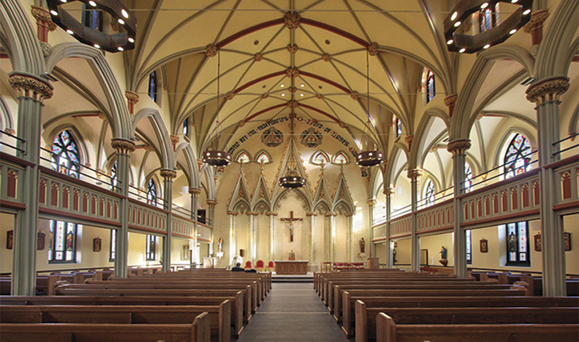After more than a decade of closed doors and legal battles, St. Brigid’s Roman Catholic Church in New York’s Alphabet City is restored and open again for worship.
Built between 1848 and 1849, St. Brigid’s, on Avenue B and Eighth Street, is among the earliest surviving works of famed architect Patrick Keely, a Tipperary native, who carved the reredos, organ case, and the original wood altar himself at only 25 years old. Keely went on to design an estimated 600-700 buildings in his lifetime, mostly Catholic churches and other religious buildings in North America.
On January 27, Mass was held in St. Brigid’s sanctuary for the first time since 2001, when the building was closed over concerns about its structural safety. The reopening came just in time for the Feast Day of St. Brigid, celebrated February 1. The restored church was officially consecrated and dedicated by Cardinal Timothy M. Dolan, who presided over the Mass.
The restoration was not exclusively a church matter and included support from numerous East Villagers, parishioners and non-parishioners alike. The legal battles were headed by attorney Marisa Marinelli pro bono; the borough fights by City Council Speaker Christine Quinn and City Councilmember Rosie Mendez; and community support came from people like Ed Torres, chairman of the Committee to Save St. Brigid’s and a former head usher; City Comptroller William Thompson; and novelist Mary Gordon.
In its early years, St. Brigid’s served as a haven for Irish immigrants fleeing the famine, and later as a stalwart presence for the ever-changing immigrant populations to the neighborhood, from the Polish and Germans, to Ukrainians and Puerto Ricans.
Despite its history as a neighborhood force, as recently as 2008 the church was still slated for complete demolition. In 2001, a formerly repaired crack re-emerged near the northeast corner, rendering the building unsound. The Archdiocese of New York officially closed the church in September of 2004.
After several failed lawsuits by parishioners, a temporary restraining order, and back-and-forth rulings by the New York State Supreme Court, demolition began on the historic church in 2006. Although a court-ordered halt came only one day later, a number of original stained glass windows bearing the names of famine immigrants were removed and destroyed, as were the remaining pews, and the demolition crew had already carved an eight-foot hole in the south wall and erected scaffolding around the church.
Nearly two years of legal stalemate went by until news came from the Archdiocese in 2008 of a $20 million anonymous donation, which stipulated that $10 million would be used for repairs, $8 million for the adjacent St Brigid’s School, and $2 million as an endowment.
While at the time rumors suggested that actor Matt Dillon, a long-time supporter of restoring the church and an East Village resident, was the donor, Joseph Zwilling, spokesman for the Archdiocese, assured the Daily News, “I will tell you it was not Matt Dillon.” Dillon simply fell in love with the church while filming scenes from City of Ghosts there and has been vocal about the necessity of preserving the church’s history.
Regardless of who the benefactor was, Ed Torres summed up the community’s feeling to the New York Times, saying, “we are ecstatic.”
St. Brigid’s Catholic Church in the East Village Reopens

The rennovated interior of St. Brigid's Church in Manhattan's East Village. Photo: Google Images.

I can’t thank you enough for this article and the photo of the inside of the church. I grew up going to St. Brigid’s School & Church. I was so saddened to hear of the demolition. God Bless the person who donated all that money.
~Madeline Sellers (now in Portland, OR-USA)
thank you so for this article . Along with my brother I too received my communion and confirmation at St Bridgid’s church. I am overjoyed that it was restored and reopened. God bless the donor
with the big heart. I hope to visit New York and attend mass.
Catherine Szkwarek Kaiser St Laurent (now Delray Beach Fl USA)
My husband donated a painting he did of a scene in Ireland for the fundraiser. We know that Mr. Torres purchased it for his mother. This painting was mine and my husband painted it for me after a trip to Ireland. I asked him to donate it because I felt it was an important cause. I would love to know where the painting is today.
God bless the person who donated the money to save this church that represents the starving Famine Irish who left British oppression and started new lives in America bringing their Celtic traditions and strong faith with them